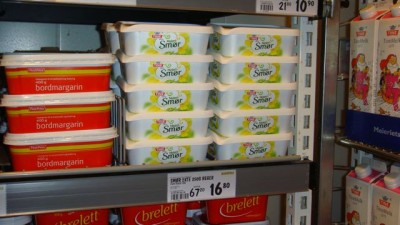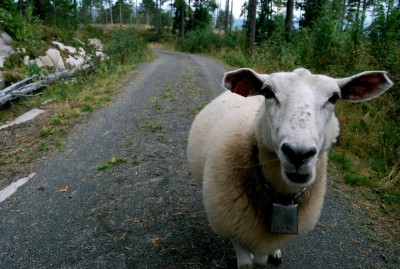COMMENTARY – VIEWS ON THE NEWS: There’s an expression in Norway that’s often applied to those who need to admit an error and even apologize for it. They “legger seg flat” (literally, they “lay themselves flat”). Company officials at dairy giant Tine, which controls around 90 percent of the butter market in Norway, should be flatter than a pancake right now but clearly lack the butter needed for pancake-making. Worse yet, Tine officials are far from alone in their recent displays of incompetence and arrogance. Exploitation of Norwegian consumers by the meat, poultry and grocery store giants has continued unabated into the New Year as well.
Here comes the second in a series of occasional “spouting off” columns, where we’re allowing ourselves to rant and rave a bit about the news and challenges of daily life in Norway. Perhaps the rants are akin to the sheer frustration of an angry housewife, but so be it. The question is why the vast majority of Norwegians simply shrug their shoulders and keep allowing themselves to be fleeced.

Buttering up staff instead of customers
It’s gone a bit quiet after Norway’s butter shortage, a result of poor planning by dairy market regulator Tine, made headlines around the world. One might think Tine would be left properly chastened, facing the loss of its market dominance and even managing to finally get ample supplies of butter back on the shelves.
But no, most stores still have little butter and erratic supplies, except for that which was finally allowed into Norway from foreign producers in countries like Ireland, France and Belgium. Tine seems to have neatly avoided any political punishment from the government officials who allow and protect Tine’s market dominance. Any self-criticism was mostly restricted to pat statements that “we haven’t foreseen the combined power of two considerable and unexpected aberrations from the norm” (higher demand and shorter supply). Tine did advertise in local newspapers just before Christmas for a new “Director of Tine Distribution,” prompting smirks from those reading that the newly created position was aimed “to ensure that we meet the expectations of our customers in an effective and good manner.” At least Tine has perhaps recognized that it needs help in meeting customer expectations.
Then came a report, in newspaper Aftenposten, that far from “laying themselves flat,” Tine managers were instead flying around 400 Tine employees to London this month for what’s ironically known as a company “smøretur” in the wake of their famous butter (smør) shortage. Tine’s communications director Elisabeth Morthen defended the seminar, which was to extend into the weekend, as “important and necessary.” London was chosen as destination for the all-expenses-paid tour so that Tine’s sales, marketing, strategic planning and business development staff “can gain a better understanding of the international competition we see more and more of in Norway,” according to Morthen.
It can only make the hapless Norwegian consumer wonder just how out of touch Tine can be. At least Tine’s own mistakes have allowed Norwegians to get a taste of French, Belgian and Irish butter. Even though it’s priced at Norwegian levels, one can only hope Norwegians will decide it tastes better, and really give Tine some competition.
Prior pumps up egg price
Meanwhile, poultry producer Prior, which dominates the chicken and egg markets in Norway, also took advantage of its market position this week. The price of a dozen standard large eggs has been steadily rising for the past few years but Prior outdid itself in socking it to consumers over the course of a weekend.
Last Friday, a dozen large Prior eggs cost NOK 39.90 at most Oslo grocery stores. On Monday, the price was suddenly NOK 42.90, or more than USD 7. Eggs from free-range chickens and those labelled as “organic” cost even more.
When the new price popped up at the check-out counter, the clerk could offer no explanation for the increase, which clearly took effect just after January 1 when stores re-opened for business. It amounted to more than three times the rate of inflation in Norway, but Prior was able to quietly impose it with apparently little consumer reaction. The protests of this writer were met with blank stares, also from the Norwegian customer next in line. Eerily, no one seemed to care that already-high prices had risen again, which can explain why producers keep getting away with it.

Meaty matters
Meat giant Gilde has also resorted to a clever tactic at the grocery stores. Instead of clearly marking packages of meat with an actual price, Gilde only offers the weight of the meat (in grams and kilos) and an irritating message “SE HYLLA” (see the shelf).
That’s where customers are supposed to find the price per kilo posted, although that’s not always the case. And then the customer has to calculate how much the small lamb roast that he or she may have picked up actually costs.
It seems a deliberate means of making it more difficult for customers to clearly see what they’re paying for Norwegian meat. Harried clerks working behind the meat counter or stocking shelves made it clear they didn’t have the time to do price calculations for their customers, and claimed they were unhappy with Gilde’s new pricing system (or lack thereof), too. As it turned out, a small boneless lamb steak cost NOK 227, or nearly USD 40. It was carefully placed back on the shelf.
Wake-up call
Can consumers fight back? There’s always the angry e-mails or letters to the market giants like Tine, Prior and Gilde, or the major grocery store chains, or the farmers’ powerful lobbying groups. They’re all to blame for Norway’s high prices, brought on by protectionist policies that have been around for years. They love to claim there’s competition in Norway, yet price levels are largely a result of strict market regulation sanctioned by the government.
Tine’s butter shortage ranked as one of the biggest business blunders of the year last year, and there have been calls for an end to Tine’s double role as commercial player and market regulator. There’s also been fresh criticism lodged over Tine’s market dominance and what many see as its arrogance.
“We’ve seen a monopoly player that abuses its market power,” Tor Andreassen, a professor at business college BI in Oslo told Aftenposten earlier this week. He thinks consumers may finally wake up and complain, but in the meantime it doesn’t appear there will be any immediate consequences for Tine, and its employees can raise a skål to another year of market dominance in a London pub.
Views and News from Norway/Nina Berglund
Please support our stories by clicking on the “Donate” button now:

